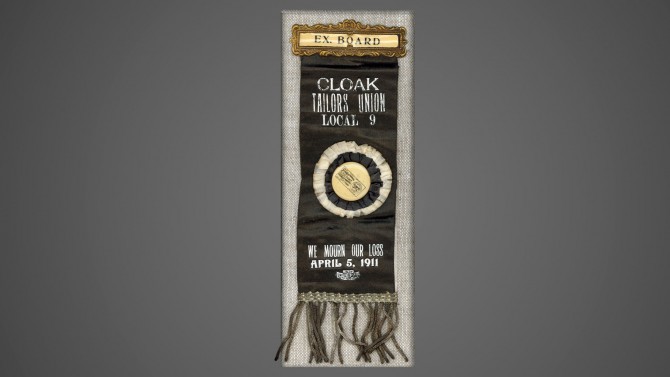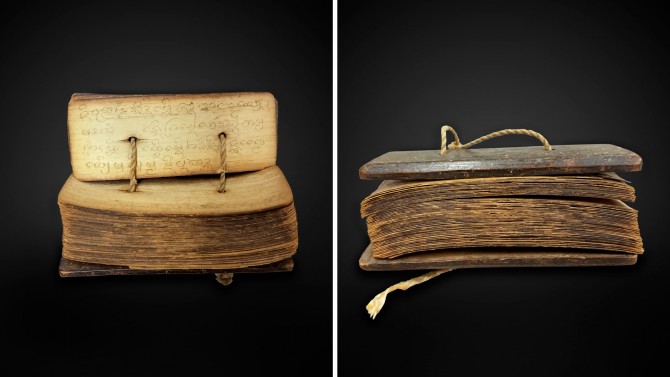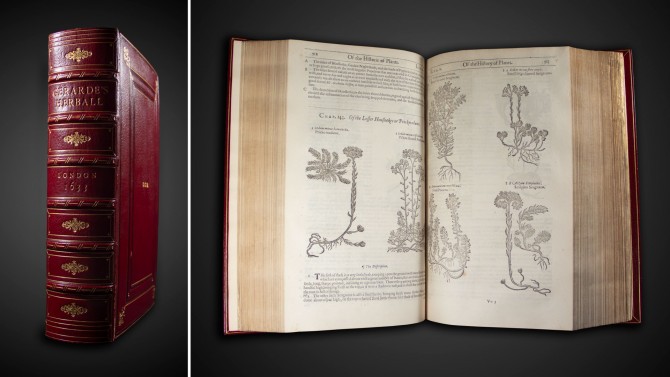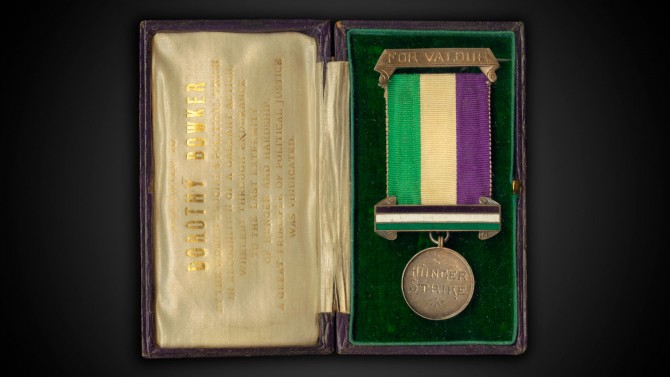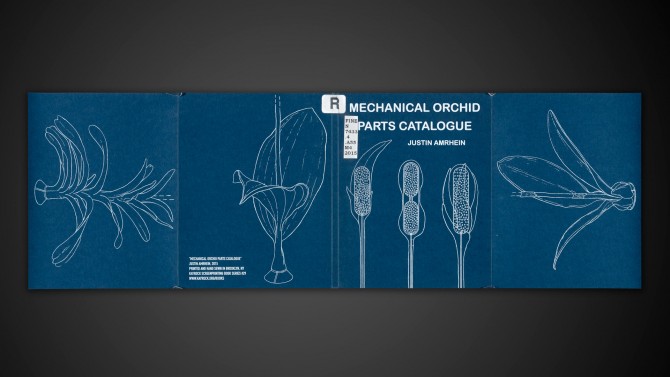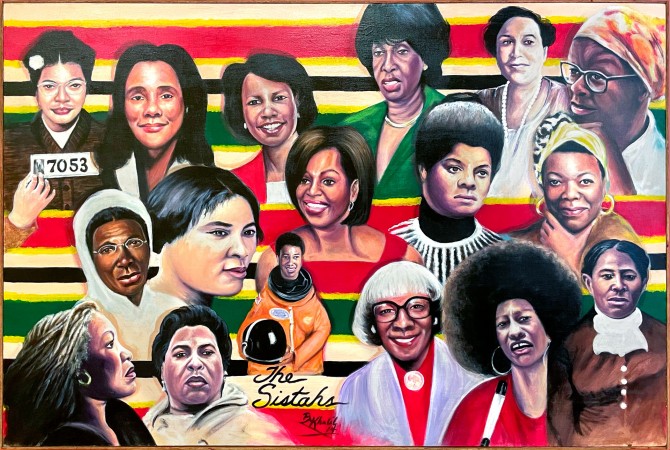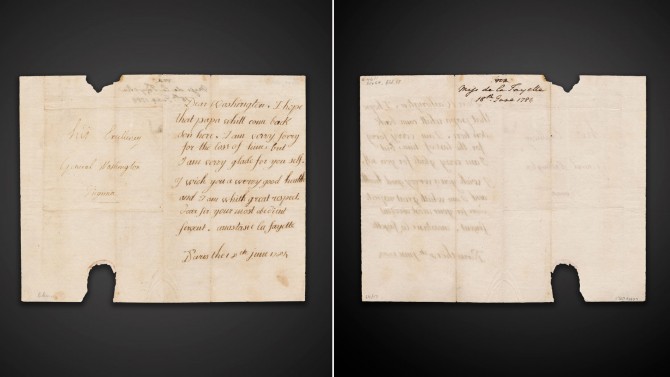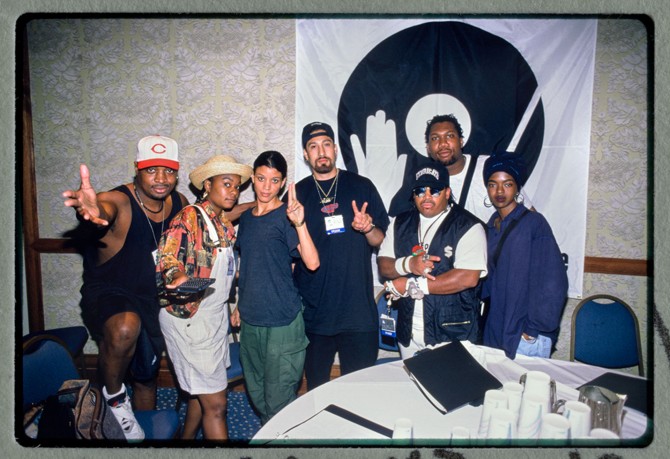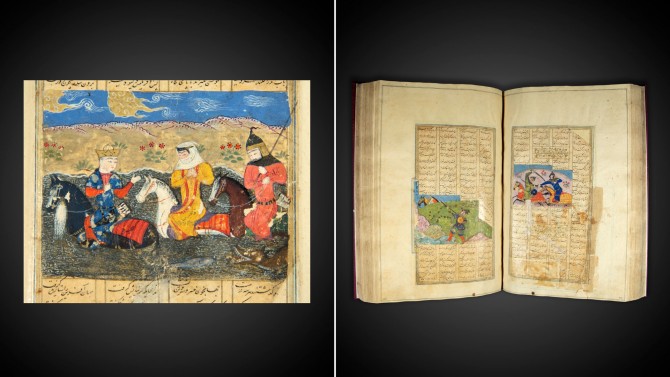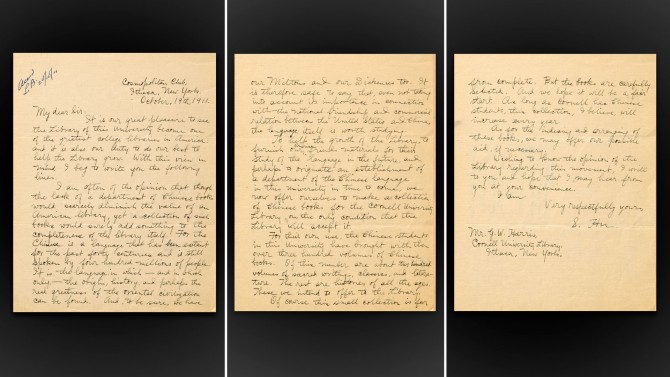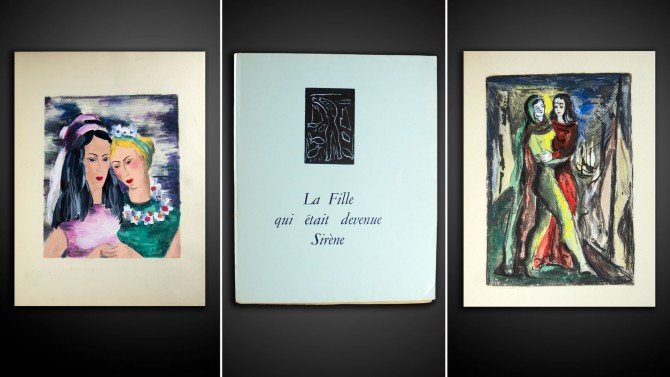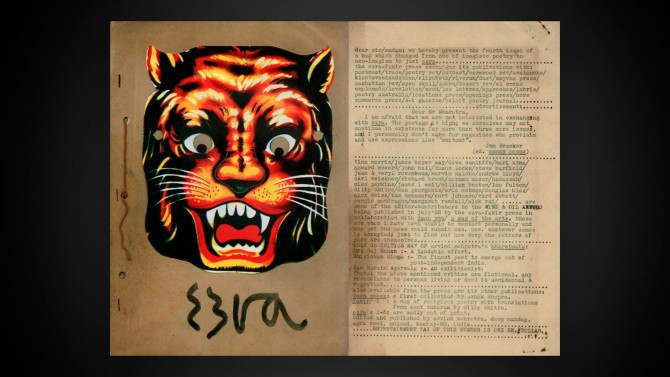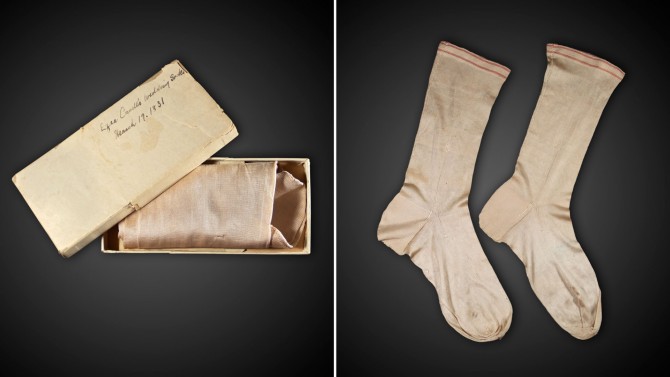Archivists and curators share their favorite artifacts
By Jose Beduya
The rich holdings of Cornell University Library support Cornell scholarship and attract researchers from all over the world. These rare and distinctive collections (lovingly referred to as “RAD” collections) also resonate deeply with the library’s own staff – speaking to their interests and passions and often evoking personal recollections.
Here are a few artifacts from RAD collections, highlighted by curators and archivists at Cornell University Library.
Get a closer look
To see any of the featured images in more detail, hover or mouse over each image to see an enlarged section with a virtual magnifying glass.
A mourning badge from union members mourning for the lives of Triangle Factory fire victims from 1911
Steven Calco, research archivist at the Kheel Center for Labor-Management Documentation and Archives
“When 146 people, mostly young Jewish and Italian women, perished in the Triangle Shirtwaist Factory fire in 1911, the nation mourned. Locked exits and faulty fire escapes highlighted the factory owners' greed, and people demanded justice. On April 5 of that year, 400,000 people marched through New York City wearing badges similar to this Cloak Taylors Union badge reading 'We Mourn Our Loss,' signifying the collective loss felt by everyone in the city. Unions organized around this tragedy, and the outrage that followed sparked national attention to the horrid working conditions of garment factories and helped transform the nation's labor code.
“This story has always resonated with me, as a first-generation Italian-American. My own mother was forced to work as a migrant laborer at 13, facing exploitation and harsh working conditions, hunched over picking strawberries in the fields or packing citrus to meet deadlines, sometimes working full 24-hour days of backbreaking labor. When I think of the plight of workers, I think of the women who perished at Triangle and I think of my family. For me, the mourning badge represents a response to injustice and shows that when people organize they can enact substantive change.”
A Daguerreotype of a mill worker, circa 1854
Marcie Farwell, the Gordon and Marjorie Osborne Textile Industry Curator at the Kheel Center for Labor-Management Documentation and Archives
“When I was a seamstress for a wedding dress designer, I always left a little of myself with each dress. Yet most of our clothing has been brought to life by strangers; their lives stitched to our own by an invisible thread.
“Historically, women made up the vast majority of the garment and textile workforce. That is still true; currently 80% of garment workers are women. In the records that came to Cornell from the American Textile History Museum, the personal photographs and letters are some of the few ways we get a glimpse into the lives of the workers. These documents are also some of the few places women's voices can be heard, since they rarely held places of power - a hierarchy that remains today.
“One such woman whose name has been passed down through time is Mary Dodge Warner, a mill worker in Lowell, Massachusetts, appearing in a daguerreotype, taken around 1854. She is likely a weaver, as demonstrated by the shuttle in her lap. The way she is dressed and her jewelry allow a glimpse into how she might have seen herself - a sense of her increased place in the world - blazing a trail for women like me to follow.”
Thai palm leaf manuscript (undated)
Gregory Green, curator of the John M. Echols Collection on Southeast Asia
“I love this manuscript because of its format, size, subject and language. The size because it is so small, much smaller than any other palm leaf manuscript I've ever seen. It can fit in the palm of your hand. The language because Lao is the language I speak best after English, and we have so few manuscripts, or even regular publications, in Lao.
“It's not a beautiful manuscript, but the subject is surprising. Most manuscripts we own are religious in nature, while this one deals with family law. I like to think of it as a pocket legal guide from the past.”
'The Herball,' or 'Generall Historie of Plantes,' by John Gerard, commonly referred to as 'Gerard's Herbal'
Deborah Cooper, digital and special collections librarian at Mann Library
“Many moons ago, when I was a carefree 20-something, I lived in the beautiful remote redwoods of far northern California, in Humboldt County. In such a remote region surrounded by vibrant natural forests full of thousands of plant species, it was totally ordinary to use medicinal plants in everyday life, as well as for even serious ailments. While I lived there, I studied botanical medicine under the tutelage of some well-known herbal practitioners and eventually taught workshops in the practice.
“Literally every book we used in our studies would mention 'Gerard's Herbal,' sometimes reprinting the illustrations, at other times tracing the lineage of a plant's use all the way back to the 17th century and earlier. I clearly remember the first time I went into Mann's vault and saw the Herbal. It's physically hefty, about 14 inches tall. The pages are beautifully pristine, and the woodcuts clearly defined. To see the original work in person, that I had been reading and hearing about for years, was profound. It really brings home the fundamental reasons why we collect and preserve these volumes for future generations.
“Up until the 17th century in Europe, most plants grown in gardens had some medicinal or culinary use. The invention of printing led to the possibility of printed herbals to illustrate the medicinal uses of plants. 'Gerard's Herbal,' first published in 1597, is one of the most famous botanical works of its time. It is comprehensive, with over 5,000 original wood engravings describing almost all forms of ancient herbs, plants and roots known in 16th-century Europe. It brings together all of the common knowledge passed down from village to village since the Middle Ages. Mann Library's 1633 edition is arguably one of the finest remaining editions in the world.”
Hunger strike medal, awarded to suffragist Dorothy Bowker
Katherine Reagan, the Ernest L. Stern Curator of Rare Books and Manuscripts
“During the early decades of the 20th century, suffrage activists used hunger strikes as a means of resistance after being arrested and imprisoned for protesting for women's rights. Some were awarded military-style medals for bravery upon their release from prison. Inscribed in the satin lined box containing this 1912 medal are the words: 'Presented to Dorothy Bowker by the Women's Social and Political Union in recognition of a gallant action whereby through endurance to the last extremity of hunger and hardship, a great principle of political justice was vindicated.'
“This piece, from Cornell Library's Woman Suffrage Collection, has always been such a powerful emblem for me, prompting reflection on the sacrifices previous generations have made to advance human rights, and that we today are the beneficiaries of their past actions. A gift from Jon A. and Virginia Lindseth, Class of 1956, it also reminds me of how grateful we are to our alumni and donors. Their gifts to the library make it possible for scholars and students to study and learn from the past.”
'Mechanical Orchid Parts Catalogue,' an artist book
Marsha Taichman, visual resources and public services librarian at the Mui Ho Fine Arts Library
“I'm responsible for the artists' books collection (ABC) at the Mui Ho Fine Arts Library. The artists' books there are in the open stacks and are actively used for teaching and research.
“Choosing a favorite book is kind of like choosing a favorite child (I only have one child, so I'm guessing), but one that I really love is called 'Mechanical Orchid Parts Catalogue.' It breaks down something living and organic into component parts, mechanizing it. The cover folds out, and is a larger blueprint of the design. It is thoughtful and thought-provoking. It's certainly not the most expensive book in our collection, but the idea is innovative, and the illustrations are deceptively technical and are well-executed. The architects that we serve render buildings in parts this way, and I think it resonates with them.”
'The Sistahs' painting
Eric Acree, director of the John Henrik Clarke Africana Library and curator of Africana collections at the Division of Rare and Manuscript Collections
“In 2014, inspired by the need for some female representation amongst the male portraits on display at the Africana Library (such as John Henrik Clarke and Black cowboys Isom Dart, Nat Love and Bill Pickett), I asked African-American Ithaca artist Khalil Bey to depict Black women who made significant contributions to American history.
“Khalil later told me, that when he began his research, he felt overwhelmed, as there were so many women to choose from. As a sports fan, I liken it to picking your favorite players from a team sport for an all-star game. Khalil ended up choosing 17 prominent women, seen from top to bottom, left to right: Rosa Parks, Coretta Scott King, Condoleezza Rice, Maxine Waters, Jessie Redmon Fauset, Gwendolyn Brooks, Sojourner Truth, Madame C. J. Walker, Michelle Obama, Ida B. Wells-Barnett, Maya Angelou, Toni Morrison, M.A. '55, Fanny Lou Hamer, Mae Jemison, M.D. '81, Shirley Chisholm, Angela Davis and Harriet Tubman. I have to admit, Khalil picked a winning team.”
Read more at the Africana Library site.
The Dora Erway Doll Collection
Eileen Keating, university records manager and assistant archivist at the Division of Rare and Manuscript Collections
“This collection is one of the many samples of Cornell student projects that are in the Division of Rare and Manuscript Collections. The original assignment was given by Professor Dora Wetherbee Erway, who taught in the College of Home Economics (now Human Ecology), 1921-45.
“From the 1920s, the collection comprises 37 dolls whose clothing and bodies were largely made by students, who in many cases used their own hair for the doll heads. The dolls represent various historical periods and nationalities. Many are exact replicas of authentic costumes, made from fabric that in many cases was already more than 100 years old in the 1920s. Because my grandparents emigrated from Austria-Hungary (today Romania), I have always been especially interested in the Romanian dolls clothed with homespun material and embroidery.”
Read about the 2020 restoration of this doll collection.
Lafayette's 6-year-old daughter's letter to George Washington
Laurent Ferri, curator of pre-1800 collections in the Division of Rare and Manuscript Collections
“This original letter to George Washington, dated June 18, 1784, was not written by a military leader or a head of state, but by a 6-year-old girl: Anastasie de Lafayette, the daughter of the French general who fought with the Americans during the Revolutionary War. The surprisingly deep father-son relationship that developed between the two men extended to their families. The document reminds us of the importance of personal bonds in world diplomacy. The document is part of an exceptional collection donated to the University Library in 1963 by Arthur H. Dean, a prominent business lawyer and the chairman of the Cornell Board of Trustees. President John F. Kennedy wrote to Charles de Gaulle to thank him for helping with the export license.”
Dear Washington,
I hope that papa whill come back Son here, I am verry sorry for the loss of him, but I am verry glade for you self. I wich you a werry good health and am whith great respect, dear sir, your most obedient servent,
Anastasie La Fayette
Paris the 18th June 1784
Illustration from Isaac Newton's 'System of the World'
Lance Heidig, reference and instruction librarian, Division of Rare and Manuscript Collections
"In their book, Murmurs of Earth, Carl Sagan and his committee describe the images and sounds they selected for the Voyager Golden Records, the phonograph records that were attached to the two Voyager spacecraft launched in 1977 to explore the outer planets of our solar system. The records serve as time capsules meant to communicate the diversity of life and culture on Earth to any extraterrestrial life that may encounter them. Our copy of Murmurs is signed by Sagan to U.S. Secretary of Defense Harold Brown."
"Wanting to show how humans have communicated, stored, and remembered information over time, the committee chose to include an image of a page from a book. After much deliberation and a visit by Sagan to the Cornell University Library Rare Book room, they decided ‘the most appropriate page to send would be the one from Sir Isaac Newton's System of the World on which, for the first time in human history, the procedure for launching an object into orbit was correctly explained and diagrammed.' The two Voyager spacecraft are the only manmade objects in interstellar space and images of Cornell's copy of Newton's 1728 book, a gift from Cornell's co-founder and first president, Andrew D. White, are on board both them, sailing for all time through the cosmos."
(Editor’s note: Lance Heidig contributed this selection while this issue of Ezra was in production. He died April 6, 2021 at the age of 64. The editors and staff of Ezra offer their condolences to Cornell University Library staff and to the many Cornellians who worked with Heidig over four decades and shared and benefited from his passion for knowledge and teaching.)
An image from the Ernie Paniccioli Photo Archive
Ben Ortiz, collection specialist for the Cornell Hip Hop Collection
“This photo by prolific hip hop documentarian Ernie Paniccioli - whose archive here at the Cornell Hip Hop Collection contains over 100,000 images - features a group of artists assembled as a speaking panel for a music conference in 1994. They are (left to right): Chuck D of Public Enemy, Roxanne Shante of the Juice Crew, Ladybug Mecca of Digable Planets, B-Real of Cypress Hill, Afrika Islam of the Zulu Nation/ Rock Steady Crew/ Rhyme Syndicate, Blastmaster KRS-One of Boogie Down Productions, and L-Boogie aka Lauryn Hill of The Fugees. This shot has always stood out to me as a favorite because it features some of the most gifted and important lyricists we've ever seen in hip hop, all of whom I personally grew up listening to. Some of my favorite tracks of all time are by artists in this photo; for example 'You Must Learn,' 'Latin Lingo,' 'Vocab Refugees Remix,' '9th Wonder Blackitolism,' 'Public Enemy No. 1' and 'Have a Nice Day.'”
Magneto-optical disk
Erin Faulder, assistant director for digital strategies, Division of Rare and Manuscript Collections
“This is an example of what we call legacy digital media that is no longer used because of technological obsolescence. It's a 12-inch magneto-optical disk that I use in teaching. It has a little label on it with additional information about the format type. But the reason I love it is because of its now-absurd size: the disk next to it is a much more well-known 3.5-inch floppy disk for size comparison.”
Firdawsī's Shahnameh (Persian: شاهنامه ) 'The Book of Kings,' ca. 1600s A.D.
Ali Houissa, Middle East and Islamic Studies curator
“This is a unique Persian manuscript of the full text of 'The Book of Kings,' with exquisite miniature illustrations. This manuscript was treated for digitization locally in the library and then rehoused. The new housing - a double-sided window mat with hinged cover - allows both sides to be viewed. The original text is considered the national epic of the Persian-speaking world, written by the Persian poet Ferdowsi between c. 977 and 1010. It tells mainly the historical past of the Persian Empire from the creation of the world until the Arab conquest of Iran in the 7th century. The work is of central importance in Persian culture and Persian language, regarded as a literary masterpiece. It is also important to the contemporary adherents of Zoroastrianism, in that it traces the historical links between the beginnings of that religion and the death of the last Sassanid ruler of Persia during the Muslim conquest.”
Letter from Hu Shih, Class of 1914
Liren Zheng, curator of the Charles W. Wason Collection on East Asia
“On Oct. 19, 1911, Hu Shih, a sophomore from China, wrote a letter to the Cornell University Library: 'I am often of the opinion that though the lack of a department of Chinese books would scarcely diminish the value of an American library, yet a collection of such books would surely add something to the completeness of the library itself. For the Chinese is a language that has been extant for the past forty centuries and is still spoken by four hundred millions of people.' He proposed: 'To help the growth of the library, to furnish our American friends materials for their study of the language in the future, and perhaps to originate an establishment of a department of the Chinese language in this university in time to come, we now offer ourselves to make a collection of Chinese books for the Cornell University Library on the only condition that the Library will accept it.' The library happily accepted his suggestion, and over 350 Chinese classic books were donated from the Chinese community at Cornell to the library.
“Hu Shih is one of the most outstanding Cornell Chinese alumni. He initiated the New Chinese Culture Movement that was a watershed moment in modern Chinese history. He also later served as Chinese ambassador to the U.S., president of Beijing University, and president of China's Academia Sinica. In 2018, to commemorate the 120th anniversary of Beijing University, we presented a copy of Hu Shih's letter as a gift to Beijing University to symbolize the long historical connections between Cornell University and Beijing University.”
My dear Sir:
It is our great pleasure to see the Library of this University become one of the greatest college libraries in America; and it is also our duty to do our best to help the Library grow. With this view in mind I beg to write you the following lines.
I am often of the opinion that, though the lack of a department of Chinese books would scarcely diminish the value of an American library, yet a collection of such books would surely add something to the completeness of the library itself. For the Chinese is a language that has been extant for the past forty centuries and is still spoken by four hundred millions of people. It is the language in which – and in which only, – the origin, history, and perhaps the real greatness of the oriental civilization can be found. And, to be sure, we have our Miltons and our Dickenses too. It is therefore safe to say that, even not taking into account its importance in connection with the national friendship and commercial relation between the United States and China, the language itself is worth studying.
To help the growth of the Library, to furnish our American friends materials for their study of the language in the future, and perhaps to originate an establishment of the Chinese language in this University in time to come, we now offer ourselves to make a collection of Chinese books for the Cornell University Library on the only condition that the Library will accept it.
For their own use, the Chinese students in this University have brought with them over three hundred volumes of Chinese books. Of this number are about two hundred volumes of sacred writings, classics, and literature. The rest are histories of all the ages. These we intend to offer to the Library.
Of course this small collection is far from complete. But the books are carefully selected. And we hope it will be a fair start. As long as Cornell has Chinese students, this collection, I believe, will increase every year.
As for the indexing and arranging of these books, we may offer our possible aid, if necessary.
Wishing to know the opinion of the Library regarding this movement, I write to you and hope that I may hear from you at your convenience.
I am
Very respectfully yours,
S. Hu.
A painting from the Helene Azenor and Alice Axel Collection
Brenda Marston, curator of the Cornell Human Sexuality Collection
“This mid-1930s oil painting by French surrealist painter Hélène Azenor (1910-99) conveys a relaxed intimacy between two women with rosebud lips, foreheads touching, and hands clasped at heart level. The original art is found inside the manuscript 'La femme qui avait été sirène (The woman who had been a mermaid)' written by Azenor's lover, Alice Axel. This exquisite draft that contains five other paintings by Azenor is one of my favorite acquisitions. A small run of 25 copies were later published as 'La fille qui était devenue sirène (The girl who had become a mermaid).' Of those, only one - the copy at Cornell - survived for the public to be able enjoy and ponder today.
“This flickering glimpse of lesbian love in Paris in the 1930s is precious to me. As a person who had to figure out what to make of my attraction to women and who didn't know that lesbians even existed until I was in college in the 1980s, this evidence from many decades before me of women who figured out a beautiful way to express their love while collaborating on artistic projects is powerful.
“Former processing archivist Phil McCray knew this meant so much to me that he put the image on a ceramic tile that I have in my kitchen. It makes me smile daily.”
'Ezra' poetry zine from the Bombay Poets Archive
Bronwen Bledsoe, curator of the South Asia Collection
“This is the cover of the first issue of 'Ezra' zine, named after Ezra Pound, hand-assembled in Bombay in the 1960s with a paper tiger mask, a typewriter, and the fervor of then-teenage poet Arvind Krishna Mehrotra. Mehrotra and his friends were poets, writing in direct and gritty vernacular English that the established presses refused to publish, much in the style of the Beat Poets in the U.S. and worldwide. Mehrotra and his rebellious young friends are now grand old men of Indian letters, and Cornell University Library is now custodian of their legacy.
“Their literary papers, the Bombay Poets Archive, hold for me all the magic of the archive itself. Ephemera, correspondence, drafts, notes and doodles are primary evidence for a brand-new literature in India's post-colonial independence. Much has happened since, but the tiger mask from the Indian 'Ezra' zine is as fresh and surprising today as it was 50 years ago. It's a pleasure to present it now in Cornell's own Ezra magazine.”
Ezra Cornell's socks
Evan Earle, the Dr. Peter J. Thaler '56 University Archivist, Division of Rare and Manuscript Collections
“Socks might not be the first thing one would expect to find in the vast Cornell history collections that make up the University Archives, yet stored amongst the other treasures in an unassuming cardboard box lies a pair of silk socks. The socks become more interesting when one learns they belonged to university founder Ezra Cornell, and even more intriguing when it becomes known they were the socks he wore on his wedding day, March 19, 1831. Perhaps the most fascinating thing about the socks is that they have traveled more than 4.5 million miles at speeds in excess of 17,000 miles per hour, while orbiting over 200 miles above the earth. Astronaut G. David Low, Cornell Class of 1980, borrowed these socks as a memento from his alma mater on his 1990 space shuttle mission. While limited in research value, the socks are a wonderful representation of what can be accomplished with a Cornell education and how the university encompasses and values everything from history to cutting-edge technological studies. While Ezra may have suggested a different object for space travel, he certainly would have been proud to see Cornell represented so far above Cayuga's waters.”
This story originally appeared in the spring 2021 issue of Ezra magazine.
Media Contact
Get Cornell news delivered right to your inbox.
Subscribe
